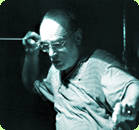
Dark Victory
by Robert Hilferty
Excerpted from an article appearing in the April issue of Carnegie Hall Stagebill.
Bernd Alois Zimmermann

Indeed, this magnum opus, which lasts just over an hour, is a musical microcosm of events which have shaped, for better or for worse, the twentieth century. It requires the participation of a large, violin-free symphony orchestra with a gargantuan percussion section, and three large choirs, a jazz combo, an organ, two orators, a soprano, and a baritone. Electronic music and natural sounds are piped in. Throughout, tapes of historic speeches and political protests are projected from speakers scattered around the auditorium.
Michael Gielen conducted the world
premiere of Zimmermann's Requiem.
 "I don't think people at the premiere realized the importance of this piece, which is unique in the panorama of twentieth-century music," asserts Gielen. What makes it unique, and significant, is the sheer scope of its own panorama. The Latin text of the Mass for the Dead is fragmented, overlaid, and distorted by a storm of recitations and historic recordings. Different historical layers collide and collude. Speeches of Pope John XXIII, Hitler, Stalin, and Mao Tse-Tung are pitted against passages by Aeschylus, Joyce, Pound, Camus, and Schwitters. Eight tongues explode in a Babel of quotations, creating a dynamic -- and disturbing -- friction of ideas and ideologies, actions and aspirations. Irony arises, for instance, when Zimmermann juxtaposes hopeful words from Beethoven's Ninth with Goebbels' demagoguery and fraught phrases from the German constitution on "human rights."
"I don't think people at the premiere realized the importance of this piece, which is unique in the panorama of twentieth-century music," asserts Gielen. What makes it unique, and significant, is the sheer scope of its own panorama. The Latin text of the Mass for the Dead is fragmented, overlaid, and distorted by a storm of recitations and historic recordings. Different historical layers collide and collude. Speeches of Pope John XXIII, Hitler, Stalin, and Mao Tse-Tung are pitted against passages by Aeschylus, Joyce, Pound, Camus, and Schwitters. Eight tongues explode in a Babel of quotations, creating a dynamic -- and disturbing -- friction of ideas and ideologies, actions and aspirations. Irony arises, for instance, when Zimmermann juxtaposes hopeful words from Beethoven's Ninth with Goebbels' demagoguery and fraught phrases from the German constitution on "human rights."
Musical quotes also abound. Amidst the dense vocal and orchestral textures emerge reminiscences of our musical past: snippets from Darius Milhaud's The Creation of the World, Olivier Messiaen's The Ascension, Beethoven's Ninth, and Wagner's Tristan and Isolde. Zimmermann even quotes his own music, not to mention the Beatles. "Hey Jude" is employed as an emblem of contemporary youth and pop culture (and, perhaps, Holocaust-haunted, the German composer saw that "Jude" resembles the German word for "Jew").
Zimmermann referred to his Requiem as a "lingual" -- a piece in which elements of cantata, oratorio, radio play, journalism, and documentary come together in a cinematic montage of sound images and cultural artifacts. (He borrowed the term from Wittgenstein, whose Philosophical Investigations is quoted at the very start.) He outdoes the giganticism of Berlioz's Grande messe des morts (which requires a compound orchestra with four brass sections) and extends Brahms' German Requiem strategy of incorporating texts other than liturgical Latin to create hyperpolyphony: a counterpoint of not only musical lines but of different media and sound masses, a polyphony of contradictory ideas, texts, and textures.
